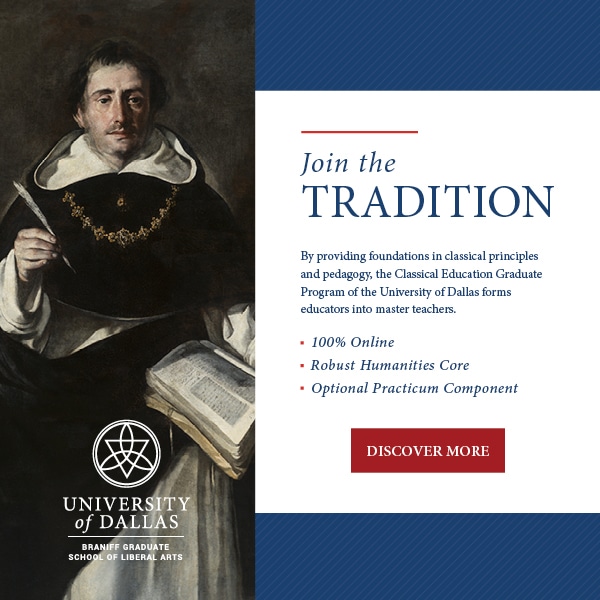Teaching Truth-and Goodness and Beauty

Once upon a time, there was a land in of pure and perfect proportion. Unlike our cities, in which highways and buildings and rivers and trees often tumble over one another in unsightly haphazardom, this land boasted hill folding into hill, building rising from building, and streets and rivers flowing in elegant curves, wherever the eye could see. But, strangely, this graceful land lacked any trace of color, sound, or scent; no music, no laughter, no gardens, no paintings, no feasts filled its symmetric architecture. Would such a land be habitable?
Classical curriculums, or perhaps the communities that use them, often emphasize classical education’s effectiveness in teaching truth. Logic programs are presented as apologetics courses or as intellectual armor against future erroneous professors; rhetoric programs become classical-styled Evangelism Explosion classes, designed to get the gospel truth out as efficiently as possible. Philosophy classes pit true and false worldviews against one another, and history curricula advertise their intent to tell the full story, what really happened, unlike public school textbooks that water down, excerpt, or otherwise rewrite the record. As one popular textbook’s title affirms, classical education aims to give students the “total truth.”
But to teach truth alone is to usher students into a world of firm foundations, pure proportion, and stately symmetry with no color or sound or scent—the world of the fable above. This world lacks all that makes the truth homey and habitable, lovely and lovable; little wonder that students tire of it, poke fun at it, seek to move out of it. It cannot be home for their souls, for it lacks goodness and beauty.
Contrast this with the original “classical education” of the medieval university. For the medievals, the trivium and quadrivium of the curriculum reflected the order and harmony of the universe itself, with all its singing spheres, and this in turn reflected the order and harmony of the nature of God. Their writings exude a passionate conviction, not only of the truth of these ideas, but also of their beauty; and, paradoxically, it is the beauty that still captivates modern readers for whom the Ptolemaic system is not the best expression of truth. Think even of their gorgeously illuminated texts, and the witness they are to the conviction of truth’s beauty.
By contrast, I have seen my students struggle to feel the conviction of beauty in their beliefs, especially over time. Though their initial encounter with worldview, logic, apologetics, and such studies often excites them tremendously, by junior and senior year, or later in college or life, this zeal often cools into a polite respect or even a slight embarrassment. I notice it occasionally in literature class when our discussion builds towards recognizing Christ and Christianity as the resolution of a dilemma—Trinitarian providence as the resolution to the problem of Oedipean fate, or Jesus’ resurrection as the resolution to all the incomplete “resurrections” in Tale of Two Cities. Not all the time, but sometimes, students feel sheepish about what they perceive as a true but trite “Sunday school answer” rather than as a true and beautiful fulfillment. They don’t question the truth that, as they’d say, “Jesus is the answer”; but they doubt the beauty of it. And I fear that, someday, that doubt will erode their belief in the truth, as well.
Thus, a great challenge and joy of classical pedagogy is the striving to orient our teaching around all three transcendentals—truth and goodness and beauty—daily discovering the ways that they ground and enrich one another, while arousing and directing our desires.
This effort should mark all our teaching, and should lead us towards daily fresh inventiveness in how we present and practice ideas with our students—but one place to start might be the most pervasive part of teaching, and probably (according to the apostle James at any rate) the most difficult for teachers to discipline: our tongues. Without realizing it, the ways that we talk, make observations, ask and answer questions, communicate volumes to our students about which of the transcendentals we value. I have noticed that I often fall naturally into asking questions that check for understanding, or truth-comprehension: Does that make sense? Do you “get” the proof? Can you hear the iambic pentameter? But to train our tongues and our students’ souls in goodness and beauty as well, we need another arsenal of questions.
We need questions that check for moral resonance. What makes this way of solving the problem “good” and this one “bad”? Is it simply a matter of efficiency, or is there a sort of analogous morality in mathematics? Should Alexander the Great have done thus-and-such? What else could he have done? Is the ending to As You Like It good or bad—and what do you mean by good? If you mean that the ending follows from the actions of the characters and conforms to the rules of the world of the play—then does that literary standard bear any resemblance to how you think of moral standards? What does the analogy help you to see?
We need questions that check for aesthetic appreciation. Does that move you? Do you see the symmetry in the equation? Can you hear the drive of that rhythm? If you had to illustrate this idea, what would you depict? What art and music flowed from these historical events—Do they present or interpret the event well, or do they reinterpret or twist it? Does that plot resolution strike you with a sense of profound completion? If not, why not?
As the summer begins, perhaps one of our teacherly goals could be to begin training ourselves to think this way, to speak this way—to reach out to the world before us, not only for truth, but also for goodness and beauty.

Lindsey Brigham Knott
Lindsey Knott relishes the chance to learn literature, composition, rhetoric, and logic alongside her students at a classical school in her North Florida hometown. She and her husband Alex keep a home filled with books, instruments, and good company.











